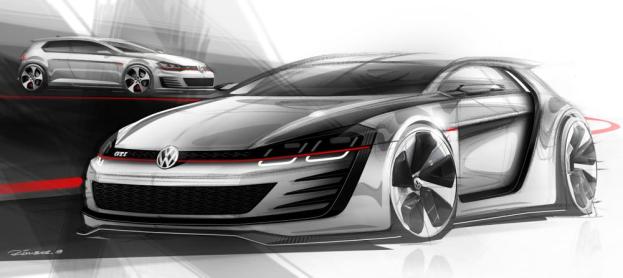 The annual Worthersee Festival is like Comic Con for Volkswagen fans. Nearly 150,000 of them are expected to make the trek to the Austrian city of Reifnitz this weekend to celebrate all things GTI.
The annual Worthersee Festival is like Comic Con for Volkswagen fans. Nearly 150,000 of them are expected to make the trek to the Austrian city of Reifnitz this weekend to celebrate all things GTI.
Volkswagen usually returns the love with a concept car or two. This year, the Wolfsburg wonders already have the Audi TT ultra quattro and SEAT Leon Cup Racer on deck, but the Design Vision GTI will probably turn the most heads.
Based on the newly minted Mark VII Golf GTI, the Design Vision GTI will boast 503 horsepower, 413 pound-feet of torque and a top speed of 186 mph (300 kph).
To put that in perspective, a U.S.-spec GTI produces just 220 hp (a Europe-only performance pack bumps output to 230 hp), and 258 lb-ft. of twist.
How did they do it? The stock GTI’s 2.0-liter four-cylinder is gone, replaced by a 3.0-liter V6. It’s backed by Volkwagen’s DSG dual-clutch automatic transmission and all-wheel drive.

To slow the car down form those insane speeds, VW gave the Design Vision GTI carbon ceramic brake discs and wheels designed to vent said brakes.
Unlike the stock GTI, which has always been a bit of a sleeper, the Design Vision GTI has styling to match its grandiose performance (and its grandiose name).
This concept is wider, shorter, and lower than a stock GTI, giving it a means, hunkered-down look. A wide body treatment helps to cover those massive bladed wheels, and accentuate’s the GTI’s signature kinked C-pillar.
As with nearly every other performance-oriented concept car, there’s also a front chin spoiler and a rear diffuser, just in case you didn’t get the message.

Those controls are limited to the DSG’s paddle shifters, the ESP stability control system, climate control, an engine kill switch, and a pushbutton fire extinguisher.
The rest of the interior is similarly racy, with bucket seats, an X-brace that takes the place of the rear seats, and Porsche-style fabric loops instead of door handles.
Keeping with the racing theme, Volkswagen did manage to work one tech feature into this concept. A camera mounted in the A-pillar records on-track action, which can be transmitted to other drivers on the course, or played back later on a dashboard screen.
The Design Vision GTI probably won’t be mass-produced, but it will probably draw as much attention at Worthersee as Joss Whedon at a Firefly screening.
Editors' Recommendations
- Volkswagen ID.GTI concept is another icon reimagined as an EV
- Too hip for a minivan? Check out VW’s all-electric ID.Space Vizzion concept
- Volkswagen Type 20 concept wraps modern tech in a classic shape


